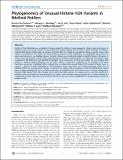| dc.contributor.author | Van Doninck, Karine | |
| dc.contributor.author | Mandigo, Morgan L. | |
| dc.contributor.author | Hur, Jae H. | |
| dc.contributor.author | Wang, Peter | |
| dc.contributor.author | Guglielmini, Julien | |
| dc.contributor.author | Milinkovitch, Michel C. | |
| dc.contributor.author | Lane, William S. | |
| dc.contributor.author | Meselson, Matthew Stanley | |
| dc.contributor.author | Malik, Harmit S. | |
| dc.date.accessioned | 2010-09-29T20:13:54Z | |
| dc.date.issued | 2009 | |
| dc.identifier.citation | Van Doninck, Karine, Morgan L. Mandigo, Jae H. Hur, Peter Wang, Julien Guglielmini, Michel C. Milinkovitch, William S. Lane, Matthew Meselson, and Harmit S. Malik. 2009. Phylogenomics of unusual histone H2A variants in bdelloid rotifers. PLoS Genetics 5(3): e1000401. | en_US |
| dc.identifier.issn | 1553-7390 | en_US |
| dc.identifier.uri | http://nrs.harvard.edu/urn-3:HUL.InstRepos:4453992 | |
| dc.description.abstract | Rotifers of Class Bdelloidea are remarkable in having evolved for millions of years, apparently without males and meiosis. In addition, they are unusually resistant to desiccation and ionizing radiation and are able to repair hundreds of radiation-induced DNA double-strand breaks per genome with little effect on viability or reproduction. Because specific histone H2A variants are involved in DSB repair and certain meiotic processes in other eukaryotes, we investigated the histone H2A genes and proteins of two bdelloid species. Genomic libraries were built and probed to identify histone H2A genes in Adineta vaga and Philodina roseola, species representing two different bdelloid families. The expressed H2A proteins were visualized on SDS-PAGE gels and identified by tandem mass spectrometry. We find that neither the core histone H2A, present in nearly all other eukaryotes, nor the H2AX variant, a ubiquitous component of the eukaryotic DSB repair machinery, are present in bdelloid rotifers. Instead, they are replaced by unusual histone H2A variants of higher mass. In contrast, a species of rotifer belonging to the facultatively sexual, desiccation- and radiation-intolerant sister class of bdelloid rotifers, the monogononts, contains a canonical core histone H2A and appears to lack the bdelloid H2A variant genes. Applying phylogenetic tools, we demonstrate that the bdelloid-specific H2A variants arose as distinct lineages from canonical H2A separate from those leading to the H2AX and H2AZ variants. The replacement of core H2A and H2AX in bdelloid rotifers by previously uncharacterized H2A variants with extended carboxy-terminal tails is further evidence for evolutionary diversity within this class of histone H2A genes and may represent adaptation to unusual features specific to bdelloid rotifers. | en_US |
| dc.description.sponsorship | Molecular and Cellular Biology | en_US |
| dc.language.iso | en_US | en_US |
| dc.publisher | Public Library of Science | en_US |
| dc.relation.isversionof | doi:10.1371/journal.pgen.1000401 | en_US |
| dc.relation.hasversion | http://www.ncbi.nlm.nih.gov/pmc/articles/PMC2642717/pdf/ | en_US |
| dash.license | OAP | |
| dc.subject | evolutionary biology | en_US |
| dc.subject | genomics | en_US |
| dc.subject | molecular biology | en_US |
| dc.subject | molecular evolution | en_US |
| dc.title | Phylogenomics of Unusual Histone H2A Variants in Bdelloid Rotifers | en_US |
| dc.type | Journal Article | en_US |
| dc.description.version | Version of Record | en_US |
| dc.relation.journal | PLoS Genetics | en_US |
| dash.depositing.author | Meselson, Matthew Stanley | |
| dc.date.available | 2010-09-29T20:13:54Z | |
| dc.identifier.doi | 10.1371/journal.pgen.1000401 | * |
| dash.contributor.affiliated | Lane, William | |
| dash.contributor.affiliated | Meselson, Matthew | |


